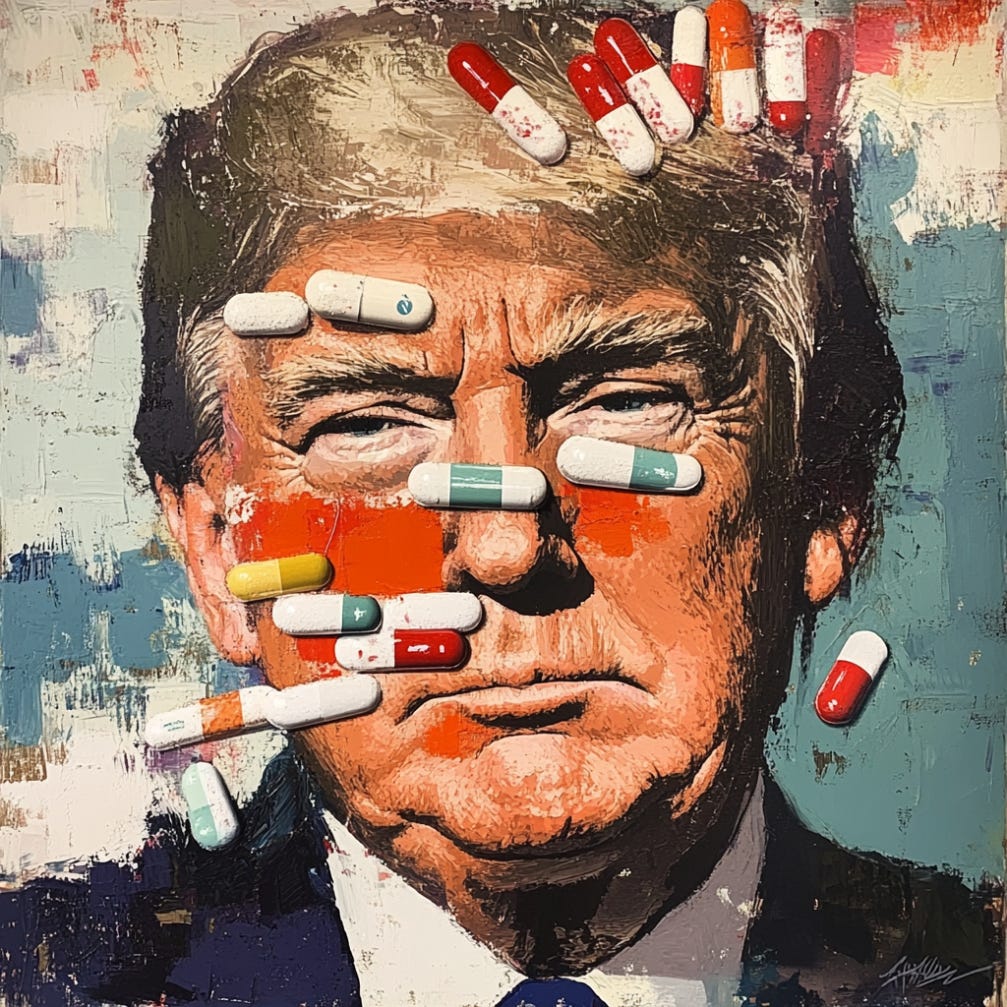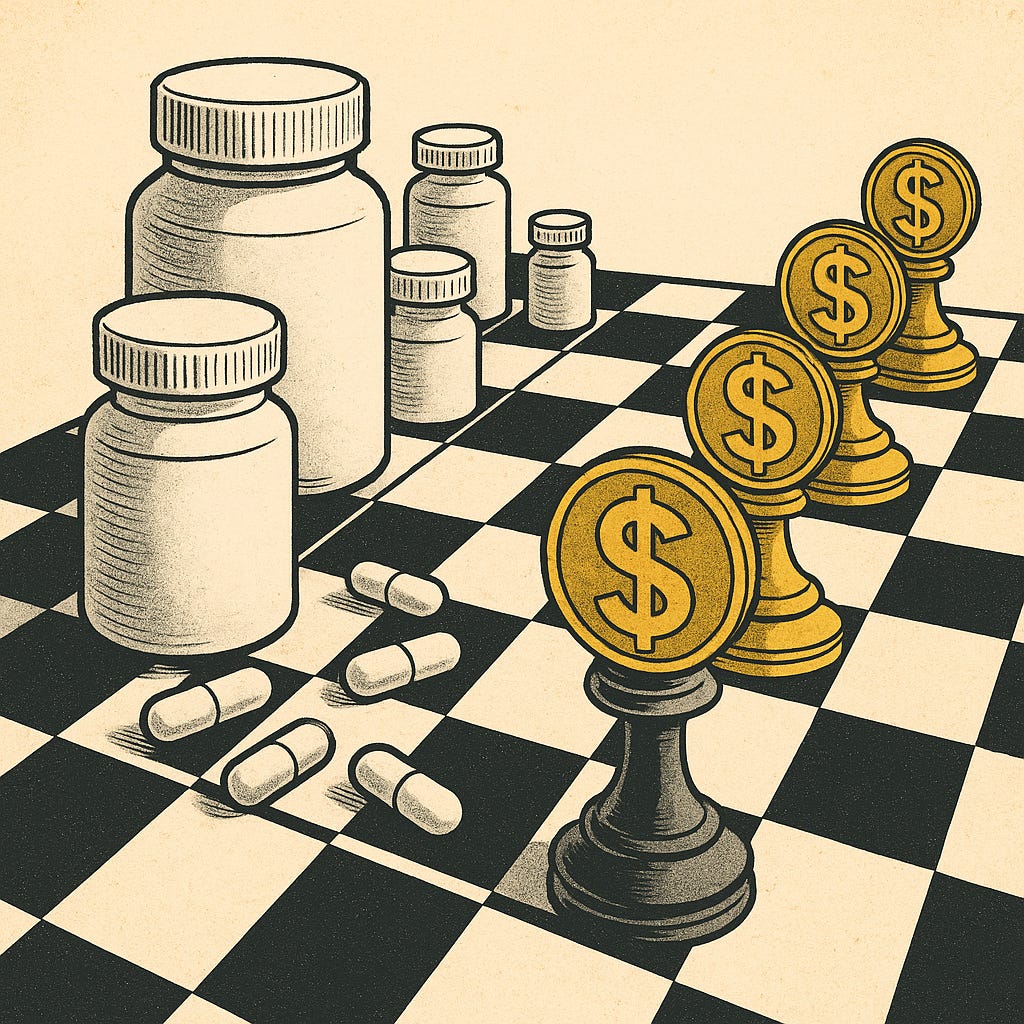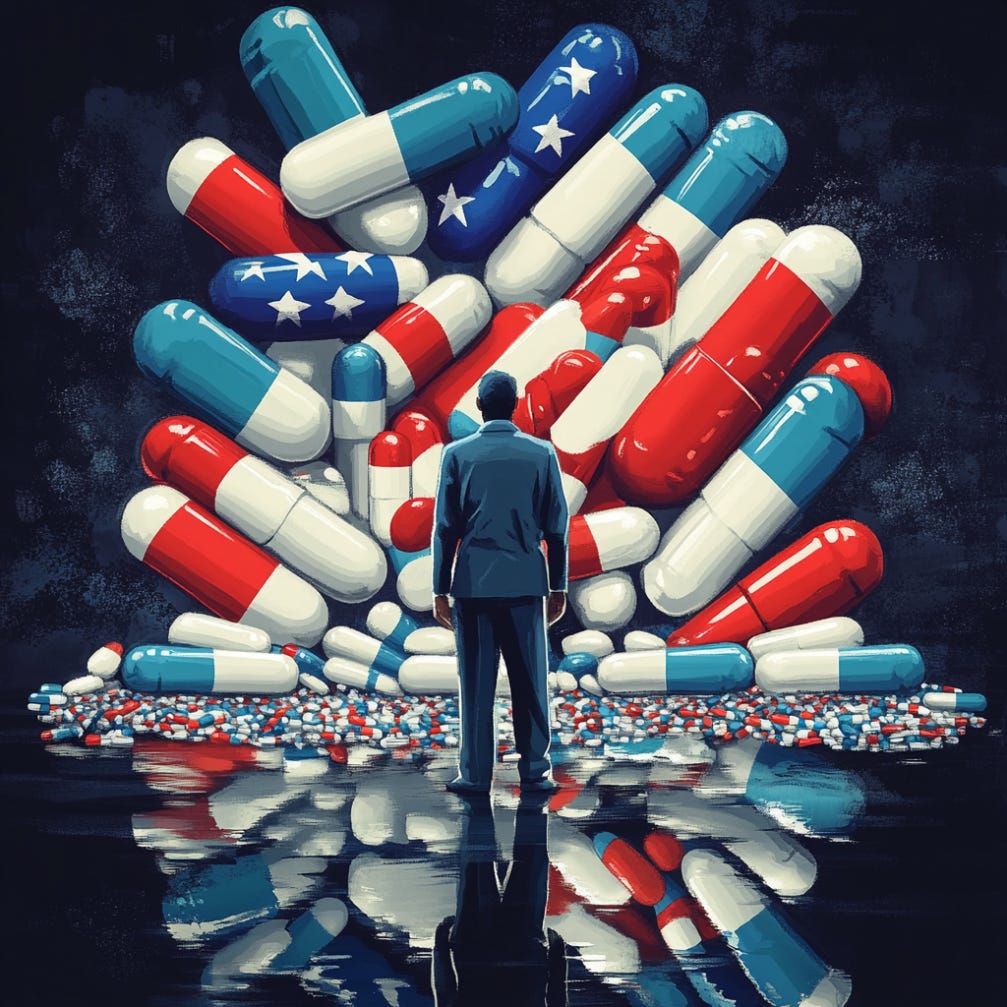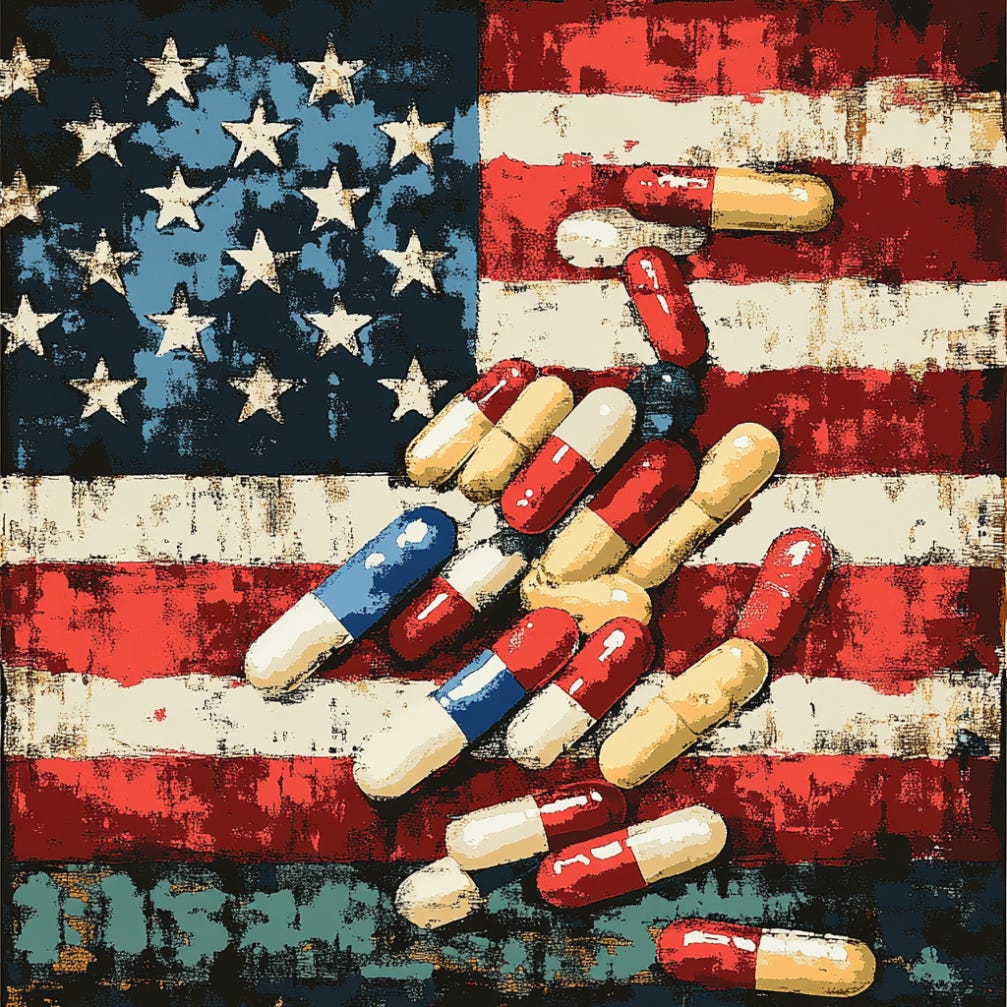Trump's Most-Favored Nation (MFN) Prescription Drug Price Cap Executive Order: May Stall Up to 70 Novel Treatments
Trump correctly identified the problem: other countries leach off U.S. pharma IP & don't contribute... but the MFN + Trump tariffs + health cabinet = going backwards...
It is well known that the U.S. subsidizes the world’s medical, pharma, and biotech innovation… the rest of the world is a complete joke and doesn’t prioritize advancing humanity… it’s just a fact. If it were up to them, global health innovation and medical progress would be mostly fucked (i.e. slow-rolled with a random breakthrough once in a while from some socialist/communist scientist).
And sure you can probably find some European pharma/biotech companies that have done something fairly innovative. All the woke idiots love to challenge the idea that U.S. subsidizes medical/pharma innovation by saying: b-b-b-but Novo Nordisk!
These clowns don’t understand that: (1) without access to the U.S. market & (2) U.S. investors & R&D; (3) other U.S. federal, state, local subsidies for Novo — you may not even know Novo exists. The only reason you know they have a pulse is because Ozempic/Wegovy (semaglutide) caught fire as a blockbuster weight loss drug.
The U.S. accounts for ~58% of Novo Nordisk sales and approximately 66-75% of profits… and American investors account for ~25% of the equity. They’d likely still be profitable, but with access to the U.S. market they can supercharge their earnings AND these earnings create a virtuous circle feedback loop wherein they can use those profits to test more novel drugs.
If it were up to me we’d have each country paying as much as the free market demands for pharma and biotech innovation because it sustains a critical feedback loop of innovation… and we advance humanity quicker. Let the market decide pricing. I also don’t think IP should ever expire; prices would drop either way because other companies would make similar compounds and they’d all be competing for your biz.
But anyways… your average person in the U.S. is so retarded they think that pharma/biotech innovation grows on trees and that big pharma is conspiring to keep them “hooked for life” and bleed them for every red cent before they die.
They don’t realize that it costs billions to bring a drug to market, the IP/patent only lasts for a critical window (wherein pharma/biotech needs to max profits so they can fund more pipelines of drugs), and most pharma/biotech are trying to effectively treat/cure diseases (and yes they have actually cured diseases — Hep C is a good recent example).
This socialism/communism mentality re: pharma/biotech is braindead. Only the rich can afford it! So what?! It wouldn’t even exist without making a lot of money off of other drugs in the past. Think of iPhones… only rich can afford initially, then they drop in price — now a huge percentage of people have one thanks to capitalism.
Furthermore, the government subsidizes a lot of medications and pharma companies often provide specialized vouchers to help even poorer people save or get new drugs at low prices.
But what about insulin? Many idiots also love to complain about insulin prices but they don’t realize that “insulin” is really damn cheap (you can buy ~$25/vial insulin at Walmart under ReliOn/Novolin).
Morons don’t understand that new insulin analogues (stemming from pharma innovation, billions invested, etc.) are NOT the same thing as the basic insulin of old. People want the new tech (faster absorption, flatter acting, longer-lasting, etc.) and demand that it be cheap.
But this demand is detached from reality. You can get a basic vehicle that’s cheap (insulin) and gets you from Point A to Point B… but you’re demanding a Ferrari (novel insulin analogue) for the same price as the beater… got it. And if you don’t get that price then Ferrari is the villain? Ahh ok, gotcha.
So because the U.S. has so many retarded people who are disconnected from reality — not realizing that medical/health innovation wouldn’t exist without the U.S. spending a lot (consumers paying high prices) and free market capitalism… many clamor for price caps (communist mentality).
It is true that other countries get U.S. drugs for cheaper (this is wrong), but the U.S. also gets these drugs much faster (e.g. ~1-year before everyone else… time is $). But your average person thinks “big pharma” execs are on private yachts, snorting coke, and nefariously plotting to cash in on making people sicker.
It is also common for idiots to think that pharma/biotech companies aren’t targeting the “true root causes.” While this line of thinking has some merit occasionally… root causes are typically genetic and/or age-related for chronic conditions. These people don’t understand that you can treat conditions without targeting root causes (lack of GLP-1/GIP agonism isn’t a root cause of obesity but it does treat it).
Alright… rant over. TLDR: There are hordes of people in the U.S. — populists, wokes, dolts — (and across the world) who don’t understand that you need the right incentives/feedback loops to accelerate medical, pharma, biotech innovation… you should want to accelerate as fast as possible because health is king (everyone benefits); currently we are going at a snail’s pace and it’s pathetic… and populist retardation is to blame.
I.) U.S. drug-pricing status quo was ripe for populist backlash
Headline facts plus one hard-to-ignore emotion primed voters for an executive order that simply said: “Match the cheapest foreign price.”
Rising Anger at High Out-of-Pocket Costs: Over the past several years, American voters have seen their prescription co-pays and deductibles rise faster than many other health expenses. Surveys by groups like the Kaiser Family Foundation (KFF) and Arnold Ventures (AV) consistently find that both Republicans and Democrats rate “cutting drug prices” as their top health-care priority. Meanwhile, comparative data from RAND and the OECD reveal U.S. net drug prices often stand at 2.5× to 3× those in other wealthy nations. Seniors on fixed incomes, in particular, feel the strain and demand federal action—feeding the momentum behind “big” policy solutions like a Most-Favored-Nation (MFN) cap.
Growing Awareness That the U.S. “Subsidizes” Most Pharma & Biotech Innovation Globally: Historically, only a niche policy audience recognized that America funds a disproportionate share of pharmaceutical R&D revenue. Now, more and more Americans are learning that Europe, Canada, and Japan effectively pay lower prices because the U.S. market’s higher margins cover the cost of developing new treatments. As mainstream news outlets highlight how foreign health systems “free-ride” on American medical breakthroughs, voter frustration grows: “If we pay more and still face enormous bills at the pharmacy, something’s broken.”
Populist Appeal of “Match the Cheapest Country”: Enter MFN (Most-Favored Nation) price-cap logic: “No American should pay more than patients in Denmark or Germany.” It’s a neat, intuitive soundbite that resonates with public anger. From a political standpoint, it sells easily: it promises a straightforward fix (just peg U.S. prices to the lowest OECD comparator) without diving into the messy details of global cost-sharing, IP licensing, or the multi-stage pipeline that yields each new drug. For many voters, the idea that “drug company greed” is the only barrier to lower prices has become a deeply ingrained narrative—setting the stage for a sweeping executive order that claims to make Americans’ prescription costs fair overnight.
II.) Why Trump’s Most-Favored Nation (MFN) Prescription Drug EO is Bad Policy
Trump correctly identified the problem: Americans are subsidizing pharma, biotech, medical, and healthcare innovation for the rest of the world. Nearly all novel breakthrough drugs are derived from the U.S. or subsidized with R&D from the U.S. market (directly & indirectly).
Tackling this problem with a MFN Prescription Drug Pricing EO is suboptimal for a variety of reasons… even if it sounds good on the surface.
The Most-Favored-Nation executive order (MFN)
On May 12, 2025 President Trump signed an EO titled “Delivering Most-Favored-Nation Prescription Drug Pricing to American Patients.”
It instructs HHS to cap every on-patent drug’s U.S. net price at the single lowest price charged in any OECD economy, across all payers public and private. HHS must publish a proposed rule within 180 days, clear OIRA review, and run a 60-day comment docket—making mid-2026 the earliest moment a binding ceiling could take effect. (MFN Pricing, The White House)
Industry is already mobilizing repeat-play litigation; in 2020 an almost identical pilot was enjoined 13 days after the final rule, and PhRMA pledges to file in D.C. and E.D. Tex. the minute this rule goes final.
Economic Damage: The Innovation Feedback Loop
U.S. Revenue Feeds Global R&D: America supplies roughly 50% of global branded-drug revenue yet only ~13% of volume (ASPE). This higher pricing margin underwrites massive research pipelines: the top 10 pharma companies alone outspend NIH, DARPA, and NASA combined.
9 in 10 Drugs Fail: Bringing a single drug to market can exceed $2.2 billion in fully loaded costs, and ~90% of candidates fail in trials. Profits from a few “blockbuster” successes must pay for all these misfires.
Short IP Window = Urgency for Returns: Patents and exclusivities last only so long; once generics enter, margins collapse. That brief window matters immensely. A 40% cut to U.S. prices translates to a ~20% global revenue dip—directly curtailing R&D budgets.
Elasticity of Innovation: Studies place the elasticity of pharma R&D at 0.25–1.5 such that a ~10% drop in expected revenue leads to an expected 2.5% to 15% decrease in pharmaceutical innovation. (USC Schaeffer, 2025) We can estimate: 0.25 elasticity = 5% R&D reduction; 0.5 elasticity = 10% R&D reduction; 1.5 elasticity = 30% R&D reduction. So if elasticity is somewhere in the middle (likely ~0.4 to ~0.7 range) — then we’d expect 2-4 fewer drugs reaching the market each year. At the highest elasticity 1.5 we’d expect ~7-8 fewer new drugs reaching the market each year.
Clinical Consequences: Delays, Shortages, and Loss of U.S. First-Access
Delayed & Withheld Launches in Cheaper Markets: Once the U.S. ties its price to the “lowest OECD net,” manufacturers have strong incentives not to launch (or severely delay) in bargain-price countries (e.g., Bulgaria, Jordan, or even smaller European states). They don’t want a rock-bottom reference hurting U.S. revenue.
Generic & Older Drug Squeeze: With a forced U.S. ceiling, low-margin generics (like many injectable hospital meds) can’t handle rising input or tariff costs. They exit, boosting shortage risk in critical care areas (antibiotics, chemotherapies).
Americans Have Historically Enjoyed Faster Access: Contrary to popular belief, European/Canadian patients often wait 6–18 months after approval for reimbursement negotiations, or never get full coverage of new therapies. The U.S. typically sees new drugs first because higher margins incentivize immediate launch. An MFN price cap jeopardizes that advantage: if the U.S. no longer offers better returns, companies may stall here too—or withhold from Europe’s low-priced markets to avoid pulling U.S. prices down.
Counterfeit/Product Quality Risks: Tighter legitimate supply plus high demand invites fake or substandard meds—particularly in regions with weaker oversight. When margins vanish for legitimate players, underground markets proliferate.
Collateral Damage to Low- & Middle-Income Countries
Tiered Pricing in Jeopardy: Manufacturers use U.S. profits to cross-subsidize cheap or donated meds (for HIV, TB, pediatric vaccines). Slashing U.S. margins dissolves those philanthropic or discount programs.
Launch Postponements Become Permanent: If low-income countries’ cheaper price would anchor a lower U.S. MFN, companies might skip those markets entirely. Instead of “late launches,” they get “never” or “off the books” distribution. (AEJ, 2023)
Deepening Global Damage: Less philanthropic supply, fewer new therapies, and more reliance on grey-market products exacerbate out-of-pocket poverty and health damage. WHO estimates 100+ million people pushed into medical poverty yearly; an MFN-driven revenue collapse only makes it worse.
Why MFN Looks “Common Sense” but Misleads
A Trojan Horse: Slashing U.S. margins (50% of global branded revenue) cripples future cures.
Time-Shifted Harm: Voters see short-term copay relief, while the pipeline damage (slower or missing therapies) comes years later — out of sight, out of mind. Short-termism 101.
Overlooking the 9/10 Fail Rate: Many assume “pharma greed,” not that a handful of blockbusters fund an ocean of failures. MFN lumps brand R&D-intensive drugs with older generics, flattening all margins. (Pharma loses billions on those 9/10 drugs that never make it to market.)
Net Result: On paper, MFN’s “equalize global prices” pitch seems fair. In reality, it means Americans lose first access (one of the prime benefits of paying more), generics thin out, and low-income nations see bigger medicine gaps. The short-term political win costs far more in the long run.
III.) Synergistic Damage: MFN + Tariffs + “Health-Populist” Leadership
The combination of MFN + Tariffs + Health Populist Leadership (e.g. RFK Jr.) is a recipe for pharma/biotech regression and/or stagnation.
1.) 10% Tariffs Hit API Costs While MFN Caps Revenue
A 10% (or more) universal import tariff means higher input costs for raw materials, especially from China or India.
MFN simultaneously forbids any offsetting price increase—manufacturers are squeezed on both ends.
Older or low-margin medicines, like injectables, may be forced out of the market, amplifying shortage risks.
2.) MAHA Leadership: “Caution-First” Approvals & Funding Freezes
READ: RFK Jr. & Trump 2.0: “MAHA Health Populism” Projected -$100B in Damages (2025-2029)
New HHS, FDA, and NIH heads advocating tighter trial standards, pausing certain grants, or demanding more “real world” data before green-lighting new drugs.
Slows the entire pipeline just as pharma sees its prime revenue (the U.S.) capped.
Fewer staff (due to “Schedule-F” reclassification or attrition) means longer queues at the FDA; each new product faces bigger hurdles, compounding the revenue crisis.
3.) Potential 2029 Crisis
If these factors persist—full MFN in effect, tariffs remain high, agency staff drained—we could see:
Major supply disruptions in certain generics or critical hospital meds.
Delayed approvals on high-risk/high-reward biologics and gene therapies.
Steep decline in biotech venture capital, as IRRs are pummeled by regulatory roadblocks + shrinking returns.
Lawmakers might scramble for emergency carve-outs or repeal under public pressure, but by that point, the damage to the R&D ecosystem could be long-lasting.
Why the Combination Is Worse Than Each Policy Alone
MFN alone cuts top-line revenue, but if companies could still control margins or pass along increased costs, the damage would be partly mitigated.
Tariffs alone might raise drug prices but would leave R&D incentives intact if there were no artificial revenue cap.
Populist leadership alone might mean more caution at agencies, but not necessarily an R&D collapse.
Together, these three form a negative feedback loop: (1) costs up, (2) revenue pinned down, (3) approvals slow, (4) supply chain disruptions—all reinforcing each other to accelerate shortages and stall new medicines.
IV.) MFN Prescription Drug Caps: Executive Order Durability & Timeline
Rulemaking & Litigation Clock
Executive Order → NPRM: The MFN EO instructs HHS to propose a rule within ~180 days. Realistically, earliest finalization is mid-2026, if everything goes smoothly (OIRA review + 60-day public comment).
Quick Injunction Risk: In 2020, a nearly identical pilot was enjoined within 2 weeks. Courts frequently grant preliminary injunctions when plaintiffs demonstrate “irreparable economic harm.” The pharmaceutical industry, hospital groups, and patient coalitions are already armed with draft lawsuits.
Potential Outcome: Even if a final rule publishes, it might never take effect if a nationwide court stay appears—historically over a 50% chance when major HHS rules face immediate legal challenges.
Congressional Realities
Filibuster or Reconciliation? A broad, private-market MFN cap likely needs 60 Senate votes to survive a filibuster, which remains unlikely. Any attempt via budget reconciliation must clear the Byrd Rule. Recent precedent (e.g., IRA negotiation provisions) carved out a limited Medicare-only approach, not a universal cap.
Lobby & Donor Influence: Pharmaceutical and biotech companies heavily fund campaigns in key states. Senators from R&D-heavy regions tend to oppose price caps that could dampen jobs or new investment.
Net Effect: A sweeping, permanent MFN across all payers stands on shaky ground—Medicare-only might be the biggest possible chunk to survive.
Most Likely Scenarios by 2029
40%: Rule gets stuck in litigation indefinitely; never truly implemented.
25%: Weaker “Medicare-only” version emerges—chopping branded revenue ~10%, modest R&D impact.
15%: Full MFN stands (if courts and Congress don’t block it), leading to a ~25% U.S. price cut and 10–20% global R&D decline.
20%: Either a meltdown triggers reversal or alternative cost-sharing legislation (like the Fair-Share Innovation Compact) supersedes the MFN.
In short, between inevitable litigation and Senate complexities, a universal MFN rule has a long, rocky road; the median outcome is that Americans never see the full brunt of an all-payers price cap, or only for a brief window before a court or Congress intervenes.
V.) A Pro-Innovation Alternative: The Fair-Share Innovation Compact (FSIC)
Something I came up with as a proposal. Probably not perfect… but trying to brainstorm something that: (1) makes other wealthy nations pay more; (2) reduces costs for Americans; and (3) accelerates pharma/biotech breakthroughs and innovation (even more than present day).
Core Principle: Instead of unilaterally capping U.S. drug revenue—thus endangering future innovation—the FSIC makes other rich countries pay more or pay into a shared R&D fund. Its design is simple:
For any country at ≥ 75 % of U.S. GDP per capita, either you set net drug prices at least 70% of the U.S. net, or you deposit the gap into a “Biomedical Innovation Contribution” (BIC) fund.
This ensures the burden of high-cost, cutting-edge therapies is shared among wealthy nations, rather than dumped solely on U.S. payers.
4 Pillars in Brief
(a) IP Shield+: Doubles down on border enforcement (Raman or DNA checks, Section 337 import bans) to crush counterfeit rings. Rapid detection triggers tariffs and data-exclusivity suspensions for serial offenders.
(b) Fair-Share Pricing Rule: If a high-income country’s net prices fall below 70% of the U.S. for 2 quarters, automatic tariffs escalate on that nation’s pharmaceutical/chemical exports—mirroring existing “Section 301” tools.
(c) BIC Fund: Each signatory contributes 0.1 % of GDP annually, generating ~$35 billion/year for high-risk R&D (antibiotics, rare disease, novel vaccines). This fund also can offset some U.S. Medicare premiums—turning foreign non-compliance into a domestic win.
(d) Carrots: 20‑Year Exclusivity + Tax Credits: FSIC signatories enjoy longer data exclusivity (extending beyond the U.S. standard 12 years) and up to a 50% R&D tax credit for approved trials, incentivizing them not to undercut global pricing.
Advantages
(i) U.S. Price Relief Without Killing Innovation: Americans see a ~20–25% net price drop (comparable to MFN’s “headline” savings), but total global top-line either holds or rises—funding new cures.
(ii) Less Launch Delay or Shortages: Because foreign payers now pay closer to U.S. levels (or contribute cash), companies don’t need to skip smaller & cheaper markets. No forced margin collapses that push generics off shelves.
(iii) Comprehensive Counterfeit Crackdown: The IP Shield+ system deters large-scale fake shipments far more efficiently than a lone customs program—violators see immediate tariff retaliation and potential capital-market bans.
(iv) Durable Under Trade Law: Embedded in a Trade-Promotion Authority bill, FSIC is treaty-backed and automatically enforces itself with tariff schedules—less vulnerable to lawsuits than a single executive-branch rule.
How It Solves the Free-Riding Problem
MFN alone just slashes U.S. revenue. FSIC lifts or balances foreign net prices, or collects a 0.1% GDP payment from nations that refuse.
That extra revenue gets funneled into the BIC fund for high-risk R&D, plus partial relief on American premiums.
Everyone pays a fairer share—and the pipeline for tomorrow’s cancer meds, Alzheimer’s breakthroughs, or anti-microbial research grows rather than shrinks.
Practical Path to Enactment
Insert FSIC language into the next Trade-Promotion Authority renewal, ensuring a simple up-or-down vote.
Leverage tariff authority: foreign exporters who balk at raising prices face stepwise penalties or capital-market lockouts.
Industry (pharma, biotech, hospital groups) sees a more stable margin environment than under MFN, so they join in lobbying for FSIC adoption.
Bottom Line: The Fair-Share Innovation Compact delivers real U.S. price cuts — minus the lethal blow to R&D. It pushes rich-country peers to fund their share or pay into the BIC, cracks down on global counterfeits, and locks each step into trade statute for automatic enforcement.
Final Take on MFN: A Trojan Horse for Drug Costs & Future Cures
The May 2025 MFN price cap offers Americans a tempting 20-to-40% retail discount, yet every datapoint we can verify shows that the bargain is illusory.
RAND’s cross-country audit confirms U.S. prices are indeed 2.8x the OECD mean, but cutting them without forcing rich peers to pay more slashes global revenue by roughly 1/5th.
The consensus elasticity of 0.4–0.7 means that move erases $18-$30B a year which translates to ~3-5 fewer novel drugs approved by the FDA each year (~30-50 over a 10-year period).
Firms then delay launches everywhere a low tag would ricochet into the U.S., repeating the 1-year treatment gap already documented in Europe’s cheapest states.
While a simultaneous tariff tier on China APIs raises costs just as margins vanish, feeding shortages and a counterfeit trade that CBP is already intercepting at 2600 consignments a month.
A lawsuit or Senate filibuster will probably kill the cap within months, but if it survives the damage spreads: Americans lose first access, rich allies keep freeloading, and poorer countries face longer lags, thinner tiered-pricing subsidies and dirtier supply chains.
A treaty-anchored alternative (like my proposed FSIC) cuts U.S. prices about the same 20%, forces Germany, Canada, Japan and others to pay 70%+ of the U.S. net or finance a $35 billion innovation pool, slashes counterfeits with IP-Shield enforcement, and actually adds 3-to-10 new drugs a year to the pipeline.
Either the United States shifts costs across borders or it chokes the engine that makes tomorrow’s cures; those are the only 2 futures the data support.
MFN Identifies a Real Problem but Offers a Dangerous “Fix”
Yes, the United States subsidizes much of the world’s drug innovation—paying higher prices while Canada, Europe, and others free-ride.
Yes, Americans are angry at sky-high co-pays and want immediate relief.
But simply matching the cheapest rich-country price undercuts the very revenue engine that drives new treatments—an engine that the U.S. has historically leveraged to get first access to the latest breakthroughs.
Why It’s a Trojan Horse
Appears to be Common-Sense: “Why should we pay 3× what Denmark pays?” plays well in sound bites.
Ignores Pipeline Reality: Cutting U.S. margins by ~40 % shrinks global R&D spend ~10–20%, delaying or killing dozens of future drugs—especially high-risk oncology or gene therapies. It also ignores the fact that the U.S. gets access to these drugs much sooner by about ~1 year (could be life-saving).
Overlooks Delays & Shortages: Firms withhold cheaper launches abroad to shield U.S. references; older generics exit as margins vanish. Patients end up with fewer, later options.
MFN + Tariffs + Populist Leadership = Triple Damage
Tariffs raise input costs exactly as MFN bars price adjustments, crushing generic and hospital meds.
Caution-first Health Officials push stricter standards, starve extramural grants, and drive staff out of FDA, compounding slowdown.
Net Result: By 2029, we risk severe supply disruptions, weaker innovation, and an even angrier electorate as drug shortages hit home.
Better Ways to Tame Costs Without Killing Cures
Cost-Sharing Models: A “Fair-Share Innovation Compact” (FSIC) forces wealthy foreign peers to pay 70 % of U.S. net or deposit the gap into a global R&D fund, preserving enough revenue to maintain a robust pipeline.
Targeted Reforms: PBM transparency, outcomes-based contracting, advanced market commitments for essential drugs, and stronger IP enforcement at the border—address real cost drivers without crippling R&D.
Bottom Line: MFN might look like a quick route to fairer drug prices, but slashing America’s revenue stream—while leaving other wealthy nations free-riding—winds up hurting U.S. patients first, draining investment in future breakthroughs, and spawning drug shortages. True policy solutions should distribute costs globally and protect the innovative ecosystem—rather than gut the one source of new therapies.







